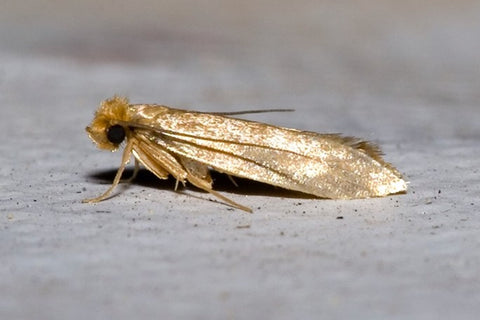Moths
Moths in your home can become a serious issue. Moths can enter your home if there is frequent movement in and out of the structure. This could happen when a door is opened, a window is left ajar, when there is a small crack into the loft, or even when carried in on clothes or furniture. These creatures will find any possible way to hitch a ride into your beloved home, especially when a light is left on.
The most common moth pests typically found in your house may be case-bearing clothes moths, common clothes moths, brown house moths, and white shouldered house moths. These are shown and identified in the images below.
Case-bearing Clothes Moth

Common Clothes Moth

Brown House Moth

White Shouldered House Moth

But what exactly are moths attracted to?
It is common knowledge that moths are attracted to artificial light, a phenomenon known as positive phototaxis. If you switch on an outside light, you will be sure to attract various species of moths. However, this is not the whole story. Larvae tend to feed on natural fibres including silk, fur, and wool. As a result, moths are attracted to woollen fabrics and stained carpets, as well as perspiration and urine. Additionally, moths are attracted to bread, pasta, nuts, cereal, and other processed pasta. For the common household, there are hundreds of reasons why a moth may find your home a great place to lay eggs, which can lead to an infestation of moth larvae.
Typical areas that moths are attracted to within your home are those dark and secluded spaces, often near plumbing fixtures, under appliances, and other isolated areas. This makes moth infestations very distressing and often requires specialist help.
When do moths in the house become a problem?
Unfortunately, warmer winters and increasingly popular clothes made from natural fibres now mean that moths are a year-long problem. Moths become a serious problem when you notice the early signs of an infestation. Therefore, it is crucial to recognise these signs.
Signs you have a moth infestation.
Finding holes in items of clothing, furniture, and dry food. This is a clear sign that pests have been feeding and arguably the most obvious clue.
Frass. Frass is the name for insect poo, which looks like small clumps of grain. This will be seen close to the holes in the damaged items of clothing or furniture.
Remnants of cocoons and webbing. You may spot silk woven around the area the lava is feeding. Cocoons are harder to spot, as these are made from the material that the moth was feeding on.
The signs of a moth infestation are sometimes categorised into four elements. These consist of:
Flying: Moths are seen appearing on walls and ceilings.
Eating: Holes begin to appear in sweaters and carpets.
Crawling: Small caterpillars are found living in clothes.
Mating: Eggs and cocoon damage inside clothes.
What do I do if I have moth infestation?
Contact us!
Book a professional moth control service. The most effective way to eliminate moths and larvae for good. We are a professional and reliable moth control company in London.
If you want to try for yourself, here are 4 steps to quickly remove a moth infestation.
https://mothcontrol.co.uk/blogs/advice/4-step-moth-infestation-guide
This is good. It should be used again here. The links to the products are great also.
